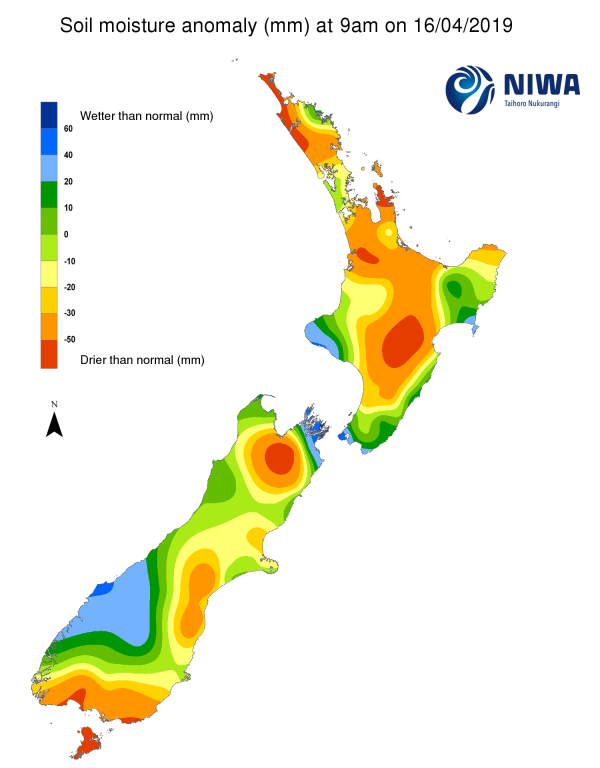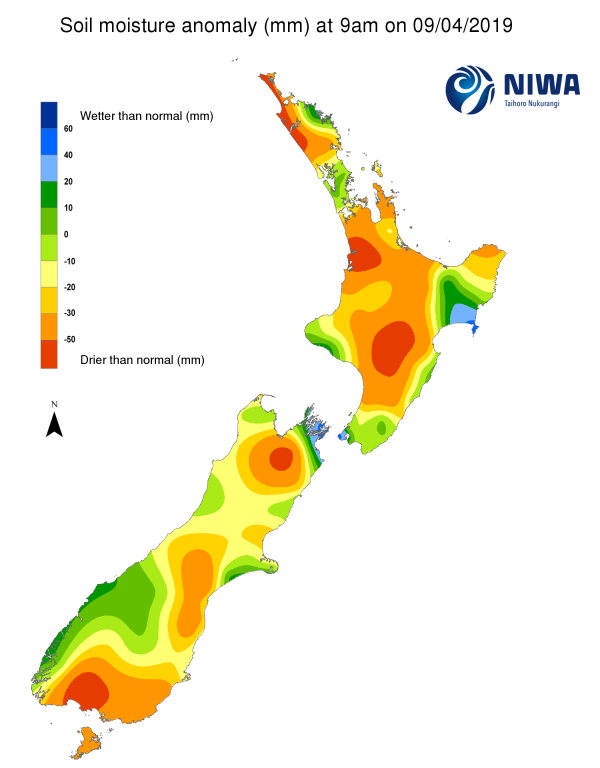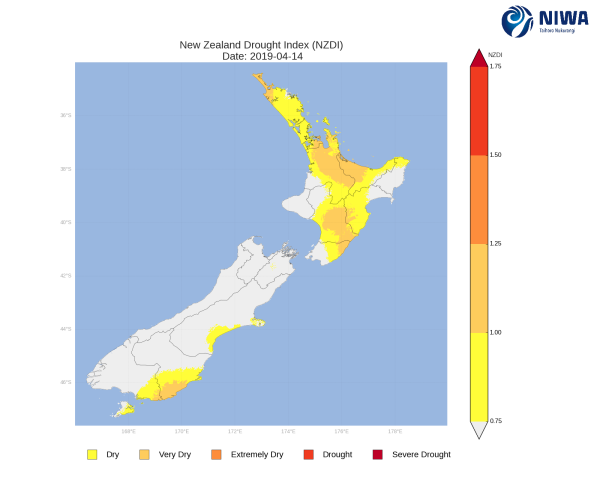A weekly update describing soil moisture across the country to help assess whether severely to extremely dry conditions are occurring or imminent. Regions experiencing these soil moisture deficits are deemed “hotspots”. Persistent hotspot regions have the potential to develop into drought.
Facts: Soil Moisture
Across the North Island, soil moisture levels generally changed little during the past week. Minor increases were observed in Taranaki and southern Wellington-Wairarapa, while slight decreases occurred in Auckland, the Coromandel Peninsula, and Gisborne. The driest soils across the North Island compared to normal for this time of the year are found in the Far North, Coromandel Peninsula, interior Manawatu-Whanganui and interior Hawkes Bay, while the wettest soils for this time of the year are located in south coastal Taranaki and Wellington City.
Hotspots in the North Island are currently in place in the western Far North District and Aupouri Peninsula, Manawatu and Rangitikei districts east to Hastings and Napier, and isolated parts of interior Waikato.
In the South Island, increases were observed along most of the West Coast, interior Otago, and Marlborough Sounds, while decreases occurred in Stewart Island. The driest soils across the South Island compared to normal for this time of the year are found in interior Marlborough, coastal Southland, and Stewart Island, while the wettest soils for this time of the year are found in the Marlborough Sounds area and lower Westland.
South Island hotspots are currently found in interior Marlborough, central Canterbury near Christchurch, and coastal southern Canterbury.
Outlook and Soil Moisture
In the North Island, high pressure will bring dry weather through Saturday (20th April). The only exceptions will be Northland and Gisborne, where onshore winds will bring light showers totalling up to 5 mm. However, low pressure arriving on Sunday and Monday will deliver moderate rainfall amounts to most locations, with totals of 20-40 mm possible across much of the North Island. Behind this low pressure, dry weather will return for the middle of next week.
Due to the anticipated rainfall amounts over the next week, soil moisture levels will likely increase at least slightly across much of the North Island. This should help conditions across Waikato and the Central Plateau in particular. In the Far North, rainfall amounts may be a bit less, so soil moisture improvements may be minimised there.
In the South Island, dry weather is expected through Friday as high pressure sits overhead. However, during the weekend (20th-21st April), low pressure moving north will deliver 40-80 mm to the West Coast, but 25 mm or less is anticipated for locations east of the Southern Alps. A weak front may bring showers on Tuesday, but additional rainfall would likely be no more than a few millimetres.
The dry areas in the eastern and southern South Island will likely miss out on the heaviest rainfall during the upcoming week, so significant improvements are unlikely. However, soil moisture levels will likely not worsen, and a few locations may see minor improvements.
Background:
Hotspot Watch: a weekly advisory service for New Zealand media. It provides soil moisture and precipitation measurements around the country to help assess whether extremely dry conditions are imminent.
Soil moisture deficit: the amount of water needed to bring the soil moisture content back to field capacity, which is the maximum amount of water the soil can hold.
Soil moisture anomaly: the difference between the historical normal soil moisture deficit (or surplus) for a given time of year and actual soil moisture deficits.
Definitions: “Extremely” and “severely” dry soils are based on a combination of the current soil moisture status and the difference from normal soil moisture (see soil moisture maps at https://www.niwa.co.nz/climate/nz-drought-monitor/droughtindicatormaps)
Hotspot: A hotspot is declared if soils are "severely drier than normal" which occurs when Soil Moisture Deficit (SMD) is less than -110 mm AND the Soil Moisture Anomaly is less than -20 mm.



